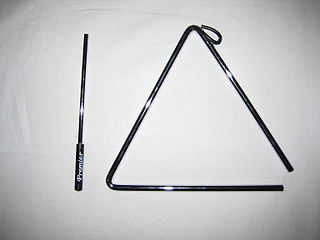This page is based on this
Wikipedia article Text is available under the
CC BY-SA 4.0 license; additional terms may apply.
Images, videos and audio are available under their respective licenses.

Sopilka is a name applied to a variety of woodwind instruments of the flute family used by Ukrainian folk instrumentalists. Sopilka most commonly refers to a fife made of a variety of materials and has six to ten finger holes. The term is also used to describe a related set of folk instruments similar to recorder, incorporating a fipple and having a constricted end.
The bubon is a Ukrainian percussive folk instrument, of the tambourine family. The bubon consists of a wooden ring with a diameter of up to 50 centimetres (20 in) which has a skin tightened over one or sometimes both sides. Occasionally, and increasingly in more modern times holes are made in the wooden sides into which metal (brass) rings are placed which rattle when the bubon is struck with the hand or a stick. The first mentions of the bubon date back to the 11th century. It was also a popular instrument among the Ukrainian Cossacks.
The kozobas - (Byjkoza) is a bowed and percussive instrument that is popular in folk ensembles in Western Ukraine. It is a recently developed instrument and is basically a wooden pole joined to a drum at one end with a cymbal hanging from the other end. The drum membrane acts as the soundboard for one or two strings strung from the end of the pole to the end of the drum. The strings are played with a bow that occasionally hits the cymbal hanging from the other end of the pole. Recent developments include instruments with four strings tuned like those of a double bass.
The dentsivka (Denchivka) is a woodwind musical instrument.
The dentsivka is often commonly called a sopilka, however, it differs from the true sopilka in that the dentsivka has a fipple, like the western European recorder. It is thus classified as a duct flute.
The telenka - - is a primitive form of dentsivka without fingerholes.
The floyara (Floyarka) is a more perfected form of the sopilka. It is characterized as an open ended notched flute. The floyara is a pipe of approximately a metre in length. One end is sharpened and the breath is broken against one of the sides of the tube at the playing end. Six holes in groups of three are burnt out in the centre of the instrument. It was often played at funerals in the Carpathian mountains. The floyarka is a smaller version of the floyara and is similar to the sopilka and frilka. The floyara is approximately 60 cm long. The mouthpiece is sharpened into a cone-like edge and the instrument produces a sound similar to that of the flute. Shepherds were also able to accompany themselves with glutteral humming which produced an ostinato tone or drone. The floyarka is often called a frilka or sometimes zubivka in central Ukraine.

The kuvytsi are the Ukrainian and Russian variant of pan pipes. Pan pipes have been found in archeological excavations in Ukraine that date back some 5,000 years. The instrument consists of several pipes each of which, when blown endwise, produces one sound. Various versions of the kuvytsi exist in Ukraine, such as the one-sided kuvytsi, which consist of a system of pipes from great to small in one lode or two-sided kuvytsi, which have their greatest pipe in the center.
The rih is an instrument that was popular in Eastern Ukraine, with between three and six fingerholes, or sometimes none. Usually they were made from a cylindrical reed with a cow's horn to form the bell. The mouthpiece usually has a single reed although occasionally double reed instruments can be found.
The Wooden Trumpet .
The truba, or lihava, is an instrument of the surma-horn type, only with a mouthpiece like that of a standard trumpet made of wood. The instrument has seven to ten finger-holes and is used in contemporary folk instrument orchestras.
The Ukrainian surma is a type of shawm that had widespread use in the armies of the Cossack host. It is thought that the instrument was introduced into Ukraine from the Caucasus or Turkey where the similar instruments exist with related names such as zurna and surnai.
The derkach is a Ukrainian version of the rattle.
The rapach is a larger version of the derkach, a type of rattle. Rapachs are used by churches in the Prešov region of Slovakia by ethnic Ukrainians instead of bells during Easter.
The torokhkalo - is a Ukrainian folk instrument used in folk ensembles whenever a drum is not available. It was also used by night guards to scare away intruders. The instrument is made from a piece of wood with a handle. A second piece of wood shorter than the first is joined to the original piece by metal rings near from the handle. A hole is drilled through both pieces at one end and a wooden bolt is placed through the hole so that the additional piece can move a small distance. When the instrument is spun around it produces a very loud sound amplified by the stillness of the night.
The briazkaltsia is a Ukrainian folk instrument consisting of copper or brass plates strung from a wire. In the past it was made of silver. When the instrument was shaken, it produced a jingling sound reminiscent of small bells. The instrument is now no longer used.
The zatula, also known as the rubal, rubel, kuchelka, kachanka, kachalka, and the rebra, is a Ukrainian folk musical instrument. It is primarily a household item used for washing and drying clothes, but it is occasionally used as a percussion instrument.
The batih is a thick stick that is rhythmically tapped on the floor in some Ukrainian folkloric groups. Pieces of metal or bottle-caps can be attached to the stick, which rattle when the stick strikes the ground. This adds to the percussive effect of the instrument.
The frilka is a more perfected form of the sopilka, a traditional Ukrainian flute. The frilka is a smaller version of the floyarka.
The zubivka also known as a.
The taraban is a Ukrainian percussive folk instrument. The etymology of the term comes from a word meaning to make a lot of noise. The taraban consists of a wooden ring with a diameter of up to 50cm (20in) which has a skin tightened over both sides.
The taraban is struck with the hand or a stick. The first mentions of the taraban date back to the 11th century. It was also a popular instrument among the Ukrainian Cossacks.
The resheto is a Ukrainian percussive folk instrument. The resheto consists of a wooden ring with a diameter of up to 50cm (20in). Initially the ring was strung with a sieve rather than a skin tightened over one side. The resheto is struck with the hand or a stick.




